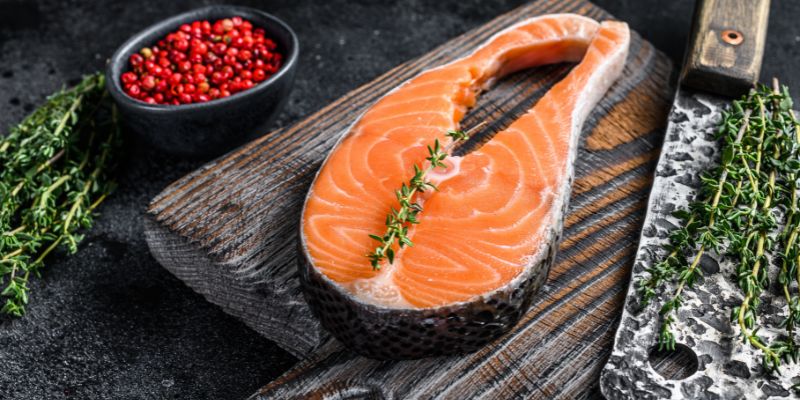Restaurants, retail stores, and kitchens value trout and salmon. Despite being compared for flavor and nutrition, these fish are significantly different. Trout and salmon have distinct appearances, tastes, nutrition, and habitats. Ichthyologists and anybody making educated dietary or nutritional decisions must understand trout and salmon distinctions. This lesson will compare trout and salmon, focusing on their physical characteristics, nutritional benefits, habitats, and optimal preparation methods. Following this comparison, you may decisively choose the appropriate fish for your palate, health goals, and culinary technique.

Critical differences between trout and salmon:
Trout and salmon belong to the family Salmonidae. However, they differ in habitat, behavior, size, and flavor. Salmon inhabit salt and freshwater throughout their lifespan, whereas most trout reside only in freshwater. These variations influence their behavior, life cycles, flavor, texture, and nutritional content. The broad migratory diet of salmon gives it its buttery taste. Freshwater trout tastes lighter. Understanding the differences between trout and salmon may improve your understanding of their flavors.
Physiological Characteristics:
Trout and salmon seem similar; yet, a more thorough examination uncovers some differences. Salmon have torpedo-shaped bodies optimized for extensive swimming during migrations. Salmon are recognized for their upstream migration, often over considerable distances, to reproduce. During the spawning season, salmon species undergo a color transformation, with males frequently exhibiting a red hue.
Speckles and patches on the skin of several trout species make them colorful and varied throughout their lives. Trout are attractive because of their brown, green, and rainbow hues. One difference between trout and salmon is size. Some salmon, including Chinook (King), weigh above 100 pounds. Trout are minor, although certain species may become large under certain circumstances. These traits separate trout from salmon in nature and affect their cooking and appearance. Salmon fillets are best for meaty recipes, whereas trout is usually cooked whole or in smaller amounts.
Taste:
Chefs and foodies must distinguish trout from salmon. Salmon's high-fat content gives it a delicious taste. Salmon's oils make it delicious when grilled, smoked, or broiled. The rich taste compliments strong marinades, spices, and seasonings, making it versatile in various cuisines. Salmon is popular as fillet, sushi, or smoked due to its strong flavor.
Trout tastes lighter and more delicate. It tastes sweet and earthy and is flakier than salmon. Trout's mild flavor pairs well with herbs, lemon, and butter. This brings out its taste without overbearing seasonings.
Evaluating Nutritional Content:
Healthy fish include trout and salmon. Salmon is rich in the fatty acid omega-3, which improves cardiovascular, cognitive, and inflammatory health. Wild-caught salmon is best for supplementing owing to its high omega-3 content. Omega-3s are crucial for cardiac health, increasing cognitive function, and preventing chronic diseases. Salmon is nutrient-dense due to its protein, the antioxidant vitamin D, and B vitamin content.

Lifecycle and Habitat:
Salmon and trout have distinct life cycles and habitats. Anadromous salmon live in fresh and saltwater. Salmon spend part of their early lives in freshwater rivers. After prolonged ocean time, they spawn in freshwater. The migratory diet of salmon, which includes freshwater and saltwater species, makes it delicious. Unlike trout, steelhead migrates like salmon. Trout in rivers, lakes, and streams eat insects, tiny fish, and other freshwater creatures. Trout and salmon taste, feel and behave differently depending on the surroundings.
Health Benefits of Salmon and Trout:
Health Benefits of Salmon:
- Salmon's omega-3 fatty acids and health advantages are well known. Beneficial fats reduce cholesterol, blood pressure, and cardiovascular disease risk. Omega-3 fatty acids prevent atherosclerosis and improve cardiovascular health by reducing inflammation.
- Salmon improves brain and heart health. Omega-3 fatty acids in salmon help elders retain cognitive clarity. Vitamin D-rich salmon improves bone, immunological, and general health.
- Anti-inflammatory omega-3 fatty acids in salmon may help arthritic patients move. Salmon protein helps athletes recuperate and regenerate muscles.
Health Benefits of Trout:
- Trout, while less robust than salmon, has several health benefits. It offers high-quality protein, making it an excellent option for muscle development or maintaining a healthy weight while minimizing caloric intake. Trout is rich in B vitamins, such as B6, B12, and niacin, which enhance energy and cognitive function.
- Selenium, an antioxidant that improves thyroid function and immune response, is also found in trout. Selenium is essential for the prevention of chronic diseases and overall health.
- Trout is an excellent choice for those monitoring fat intake owing to its low-fat content. It has a lower omega-3 content than salmon, although it maintains a commendable nutritional balance and is compatible with a lean protein diet.
Culinary Arts & Preparation:
Preparation of salmon:
Salmon's fat content makes it great for grilling, smoking, and broiling. Salmon's oils keep it moist and flavorful at high heat, making it ideal for beginners. Its rich taste accentuates hot rubs, sour marinades, and robust spices.
Trout Preparation:
Due to its delicate texture, trout's delicate flavor can be enhanced by baking, poaching, pan-searing, or gently broiling and pairing it with fresh herbs like dill, parsley, thyme, lemon, garlic, and butter.
Choosing the Healthiest Options: Wild vs. Farmed Fish
It is crucial to choose either wild-caught or farmed salmon or trout. Wildlife and agriculture influence all species' nutrition, taste, and sustainability.
Selection of Salmon:
Wild-caught salmon is healthier due to its higher omega-3 fatty acid content and reduced pollution levels. Wild salmon ingest plankton, krill, and other organic matter in their natural habitat, enhancing their taste and nutritional value. Antibiotics have a diminished impact on wild salmon. Retailers provide more affordable and readily available aquaculture seafood.
The diet and feeding practices of farmed salmon may influence their nutritional composition. Grain and other processed feeds may diminish omega-3 levels in farmed salmon. Farm-raised fish may harbor PCBs. Do you prefer sustainable salmon? Select it. The Aquaculture Stewardship Council (ASC) and Best Aquaculture Practices (BAP) may aid purchasers in selecting ethical, sustainable, and nutritious seafood.
Choice of Trout:
Trout, like salmon, maybe wild-caught or farmed. Wild trout eat insects, tiny fish, and other natural foods in rivers, streams, and lakes. This gives trout a more robust taste than farmed. Fresh, nutritious wild-caught trout is famous.
Rainbow trout thrives in well-regulated aquaculture systems. Farmed trout may have lower omega-3 levels than wild trout, but it may still be healthy. Farmed trout is safer and more sustainable than salmon and has fewer pollutants.
Conclusion:
Trout and salmon are favored for valid reasons. Both provide unique flavors, textures, and nutritional benefits that suit various dishes. Comprehending the primary differences between these two fish will assist you in making a selection based on your preferences and dietary requirements. Meticulously selected fish is palatable and nutritious, promoting sustainable fishing practices that protect these species and our aquatic ecosystems for future generations. When buying or preparing fish, selecting trout or salmon guarantees a healthier option that benefits the ecosystem.







